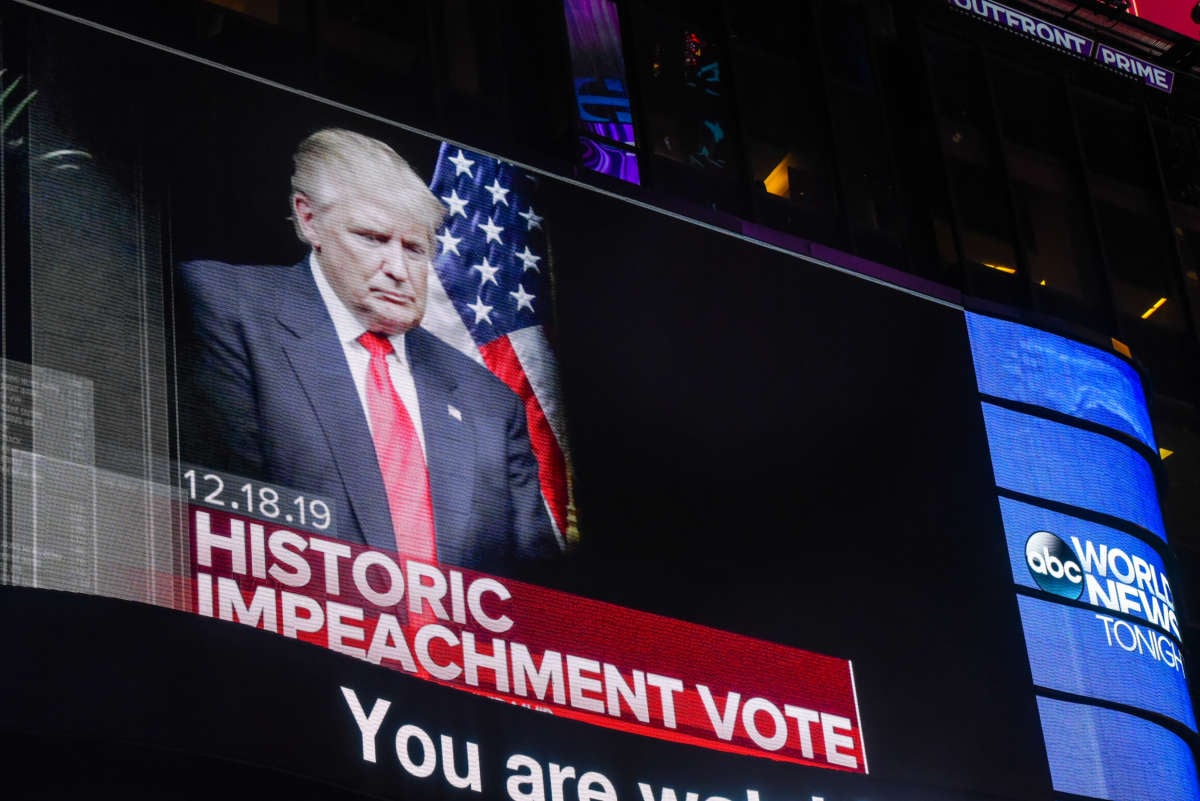Political candidates and groups shelled out millions on impeachment-related TV ads before the House impeached President Donald Trump Wednesday, according to a new report from the Wesleyan Media Project.
The analysis, produced in partnership with OpenSecrets, reveals that ads mentioning impeachment accounted for at least $16.9 million worth of TV ads in presidential, Senate and House races.
That spending is largely concentrated in the presidential contest. Billionaire Democratic presidential hopeful Tom Steyer spent $8.5 million on the air backing impeachment, with 18 percent of his ads mentioning the subject. Almost all of Trump’s TV ads since October — totaling $4.4 million — are focused on impeachment.
The Trump campaign is fundraising heavily off impeachment, sending out email blasts minutes after the House vote to impeach promising to triple-match donations during the next 24 hours with a hefty $4 million goal.
Impeachment has leaked into House races, too, where related TV ads are largely funded by “dark money.” Conservative dark money group American Action Network hammered swing district Democrats with roughly $2.4 million in impeachment-focused ads. Pro-Trump nonprofit America First Policies, which also keeps its donors secret from the public, chipped in $664,000 to pressure House Democrats. This spending is not reported to the Federal Election Commission because the ads don’t expressly advocate for or against candidates.
America First operation also raked in significant cash fundraising off impeachment, raising a combined $6.9 million along with its affiliated super PAC America First Action in the week following House Democrats’ announcement of the impeachment probe.
Despite pressure from conservative groups, all but two Democrats voted to impeach Trump for abuse of power. Rep. Jared Golden (D-Maine), a freshman representing a conservative leaning district, voted for the first article but voted against the obstruction of Congress charge. Republicans believe they can take back House seats in Trump-won districts from Democrats who supported impeachment.
Defend American Democracy is the biggest pro-impeachment group spending on TV ads. The dark money group, which is backed by the liberal dark money network Sixteen Thirty Fund, spent at least $178,590 on TV ads urging House Republicans to impeach Trump.
No Republicans voted for impeachment Wednesday. Rep. Justin Amash (I-Mich), who left the GOP in July over its defense of Trump, voted for both articles of impeachment.
“It seems that Republicans are going on offense when it comes to the issue of impeachment, while Democrats are remaining mostly quiet on the issue,” said Travis Ridout, co-director of the Wesleyan Media Project. “The one exception here is Democrat Tom Steyer who has long advocated for impeaching the president.”
Limited Transparency
Groups that do not disclose their donors sponsored more than 90 percent of all ads from outside groups in Senate races and at least three out of every four ads in House races.
Nearly three times as many Senate dark money airings in 2019 came from liberal groups than conservative. This follows the first election cycle where liberal dark money groups reported more spending than their conservative counterparts to the FEC.
A mysterious pop-up dark money group called Doctor Patient Unity has spent roughly $28 million on ads, purchasing more ads mentioning federal candidates than any other group this year, followed by American Action Network and America First Policies on the right then House Majority Forward and Majority Forward on the left. Not a single group in the top-10 list of ad sponsors based on the number of ads purchased discloses its donors.
Digital Ads Take on TV Among Presidential Hopefuls
The 2020 election cycle has seen more than $150 million in political ad spending from presidential candidates on broadcast TV on top of another $40 million airing on cable, according to Welseyan’s report in partnership with OpenSecrets.
Digital ad spending by 2020 presidential campaigns alone has topped $100 million. Compared to TV and radio ad buys, digital ads make up more than a third of all 2020 presidential election ad spending.
Trump’s re-election campaign, boosted by its joint fundraising committee’s spending, continues to be the top-spending online ad sponsor in the 2020 election. Trump’s re-election effort spent more than $40 million on digital ads since tech companies and social media platforms started releasing their advertising data in 2017. But that dynamic may change now that other wealthy candidates like Michael Bloomberg and Steyer have thrown their hats in the ring.
Steyer has spent roughly $20 million on digital ads since his campaign launched in July, according to an OpenSecrets analysis of digital ad data from Google, Facebook, Twitter and Snapchat. In the weeks since his campaign launched, Bloomberg has already poured more than $12.7 million into digital advertising.
Bloomberg’s roughly $90 million combined TV and digital ad spending during the last month put his campaign ahead of every other presidential contender as well. The second biggest overall ad spender among presidential contenders during the last month and overall is Steyer.
Bloomberg and Steyer each spent more on ads than all other current presidential candidates combined this year, including Trump.
Join us in defending the truth before it’s too late
The future of independent journalism is uncertain, and the consequences of losing it are too grave to ignore. To ensure Truthout remains safe, strong, and free, we need to raise $24,000 by the end of today. Every dollar raised goes directly toward the costs of producing news you can trust.
Please give what you can — because by supporting us with a tax-deductible donation, you’re not just preserving a source of news, you’re helping to safeguard what’s left of our democracy.
